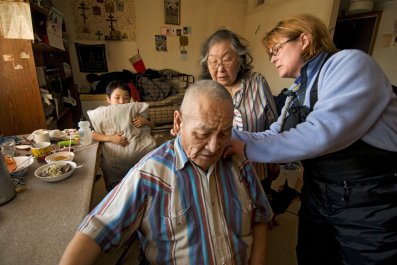Following his doctor's orders, Jay Kallio went in for a routine breast cancer exam in 2008. Though Kallio had been living as a man for two years, he retained breast tissue after his transition, so he continued to receive cancer screenings for traditionally female cancers. A few weeks after the exam, the phone rang. "I'm sitting at home, thinking everything is hunky-dory with this last mammogram, and a radiologist calls to say, 'I wanted to see how you're doing with your diagnosis,'" Kallio recalls. "And I said, 'What diagnosis?'"
Kallio's doctor had failed to inform him that the latest mammogram showed a particularly aggressive form of cancer—one for which even a few weeks' delay in treatment can make a difference in the outcome. "He was the head of surgery at a major New York City hospital, and he couldn't even call me up to give me my biopsy results," Kallio says. He then called the doctor, but the doctor wouldn't call him back. "It went on for weeks."
When Kallio finally went into the office, his doctor tried to justify avoiding the calls by saying his first impulse was to recommended psychiatry instead of chemotherapy or radiation for Kallio. He added that he didn't know what to call Kallio, who tried to be "very solicitous," telling the doctor he could use Jay, what his friends call him, or Joy, his birth name. But the doctor didn't seem to be put at ease. "I felt like I was something that smelled awfully bad in his waiting room, and a ticking time bomb that might explode on him at any moment," Kallio says. "He made it clear he was totally uncomfortable with my transgender status."
Discomfort—or blatant discrimination—on the part of doctors and nurses is just one of a host of factors that make catching and treating cancer a challenge in the trans population. There's also the still-unknown relationship between long-term hormone therapy and cancer; a lack of understanding among trans patients and doctors about what screenings are necessary; and obstacles from the health insurance industry regarding what screenings, tests and treatments will be covered.
Most of all, there's no good data. "There's just been a real paucity of long-term medical outcome research done with transgender people," says Dr. Robert Garofalo, director of the Center for Gender, Sexuality, and HIV Prevention at the Ann & Robert H. Lurie Children's Hospital of Chicago. More and more young adults and teens are coming to him seeking to transition, and while he feels comfortable prescribing cross-sex hormones, Garofalo says it can be difficult to justify this to skeptical parents, given the incomplete information on the potential consequences of hormone therapy started at early ages.
He hopes that will change. Garofalo is one of a handful of researchers with funding from the National Institutes of Health to study the transgender youth population, as the first part of a $5.7 million, five-year investigation launched in 2015. They are now beginning to enroll young adults in studies that will track health outcomes over their lifetimes—but it will likely be 15 to 20 years before those studies yield information on the long-term health risks of trans patients.
On the other hand, doctors can already make some pretty good guesses, says Dr. Madeline Deutsch, clinical director at the University of California, San Francisco's Center of Excellence for Transgender Health. "It scientifically makes sense that if someone is on hormones for decades, it's highly likely that they're going to be at higher risk [for certain health issues] than someone who started taking hormones at age 40 or 50." In addition, a trans woman taking estrogen likely has a higher risk for breast cancer than if she has not taken the hormone and had remained biologically male. Trans women taking estrogen may have a slightly lower risk for prostate cancer because estrogen protects against that illness.
There are other practical obstacles to data collection, including the use of electronic health records that force patients to choose "male" or "female." Today, some records will differentiate between male, female and trans (sometimes adding "trans male" and "trans female"), but the varying data make it impossible to compare health outcomes over years, Deutsch says.

In addition, transgender individuals are more likely than the general public to not have health insurance and therefore tend to avoid going to doctors and instead find treatment outside of a professional health care setting. Kellan Baker, a senior fellow at the Center for American Progress, a Washington, D.C.-based public policy research organization, says that before the Affordable Care Act, insurance companies could deny coverage to transgender patients because being transgender could be considered a pre-existing condition. Even under the ACA, many health care plans have clauses that allow insurers to exclude trans patients or deny them care—including transitioning and screenings that don't match the patient's gender identity. The insurance industry has been allowed to get away with this, Baker says, because for many years advocates of trans health didn't have enough clout to swap policy-makers. That is now beginning to change, he said.
Transgender people who have been denied jobs or are unemployed have frequently turned to sex work or day labor to earn a living, Deutsch notes, pointing out that in 30 states it is legal to fire someone for being trans. Unemployment and financial insecurity are direct predictors of poor health outcomes, she says. Ale Tristan, a 29-year-old trans woman living in Washington, D.C., told Newsweek that when she was 14, she was kicked out of her home by her family in Mexico and took a bus to the nearest city, where she turned to sex work to try to make money. That's how she learned about hormone therapy. "All the trans girls I worked with were taking hormones," she says. "Instead of doing it once every month, I wanted to see changes in my body, so I was taking two every month."
Tristan started taking birth control injections and hormone pills she bought on the street when she was 15 and continued for two years without ever seeing a doctor. She stopped transitioning at age 17 and then began again a decade later, once again buying hormone injections off the street and this time adding pills she found on the internet that were shipped from Thailand. Eventually, she went to Whitman-Walker Health, a Washington, D.C., clinic that specializes in LGBT health, and began transitioning under a doctor's care.
As more transgender individuals come out at earlier ages—and as more trans people are coming out instead of living in silence in general—and pursue gender transition, the health care system is being forced to rapidly adapt. "It has been a state of emergency for a very long time—trans people not being able to get access to health care services," says Baker. One of the first factors that need to be addressed is the lack of preventive screenings. Like Tristan, many transgender individuals avoid going to the doctor because of fears about costs and discrimination. The landmark National Transgender Discrimination Survey in 2012 (a follow-up is expected later this year) found that nearly 20 percent of trans individuals reported an outright refusal on the part of doctors to care for them. Almost a third said they'd postponed medical care at least once due to discrimination.
Beyond that, there's often confusion or a lack of knowledge about which screenings are necessary. After transitioning, female-to-male patients who retain their ovaries, cervix and some breast tissue will still be at risk for typically female cancers, while male-to-female patients will still need prostate exams and, as they develop breast tissue and take estrogen, breast exams, according to recommendations from the National LGBT Cancer Network. Matching the screenings to body parts is only one part of the task; doctors must also be sensitive to how patients feel about their bodies. "It's difficult to talk about cancer screenings when certain organs aren't part of who their identity is," says Dr. Raymond Martins of the Whitman-Walker clinic.
The good news is that in May, the U.S. Department of Health and Human Services issued Rule 1557, which Baker calls a "game changer" for trans health. The rule made it illegal for federally funded insurers and health care providers to discriminate on the basis of race, color, national origin, sex, age or disability. Now, Baker says, the challenge is getting them to cover the right screenings and treatments without administrative appeals and legal fights.
"The rationale given by carriers is they're not sure why they would need to pay for a cervical Pap test on someone who is male, but when people transition they may still have their cervix," Baker says. "From a medical point of view, if you've got it, you've got to get it checked out. Cervical cancer doesn't discriminate. It doesn't care whether you have a beard or not."
Update: This story was updated to clarify a quote from Kellan Baker.



















